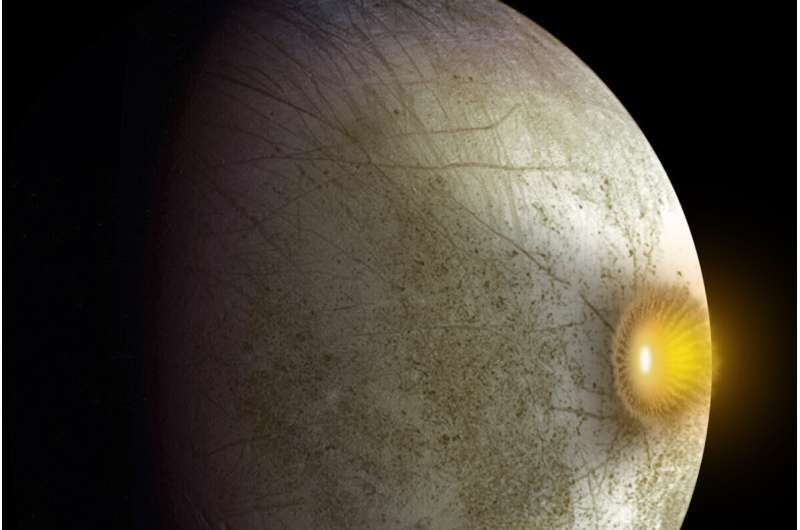Monica Kortsha writes:
Comet strikes on Jupiter’s moon Europa could help transport critical ingredients for life found on the moon’s surface to its hidden ocean of liquid water—even if the impacts don’t punch completely through the moon’s icy shell.

The discovery comes from a study led by researchers at The University of Texas at Austin, where researchers developed a computer model to observe what happens after a comet or asteroid strikes the ice shell, which is estimated to be tens of kilometers thick.
The model shows that if an impact can make it at least halfway through the moon’s ice shell, the heated meltwater it generates will sink through the rest of the ice, bringing oxidants—a class of chemicals required for life—from the surface to the ocean, where they could help sustain any potential life in the sheltered waters.
The researchers compared the steady sinking of the massive melt chamber to a foundering ship.
“Once you get enough water, you’re just going to sink,” said lead author and doctoral student Evan Carnahan. “It’s like the Titanic times 10.”
Whether oxidants can get from where they naturally form on Europa’s surface to the ocean is one of the biggest questions in planetary science. One of the goals of NASA’s upcoming Europa Clipper mission to the icy moon is to collect data that can help narrow down answers.
For now, comet and asteroid impacts are among the most plausible mechanisms. Scientists have spotted dozens of craters on Europa’s surface, many with a distinct rippled appearance that suggests frozen meltwater and post-impact motion beneath the crater.
Like Europa, Saturn’s moon Titan may also hold an ocean of liquid water beneath an icy shell. Rosaly Lopes, the directorate scientist for the Planetary Science Directorate at NASA’s Jet Propulsion Laboratory (JPL), said that this model can help scientists understand the role impacts might have on other icy worlds.
“In the case of Titan, this is very important because Titan has a thick ice crust—thicker than Europa’s,” she said. “We’re really interested in the application of this study.”
Complete article at Phys.org.
Dilute concentrations of oxidants do not provide a naturalistic pathway from non-life to life.
Here’s some info on oxidants:
Oxidant by-products of normal metabolism cause extensive damage to DNA, protein, and lipid. We argue that this damage (the same as that produced by radiation) is a major contributor to aging and to degenerative diseases of aging such as cancer, cardiovascular disease, immune-system decline, brain dysfunction, and cataracts.
https://www.pnas.org/doi/10.1073/pnas.90.17.7915
Oxidants include chemicals such as ozone, hydrogen peroxide, and chlorine.
https://www.sciencedirect.com/topics/earth-and-planetary-sciences/oxidant